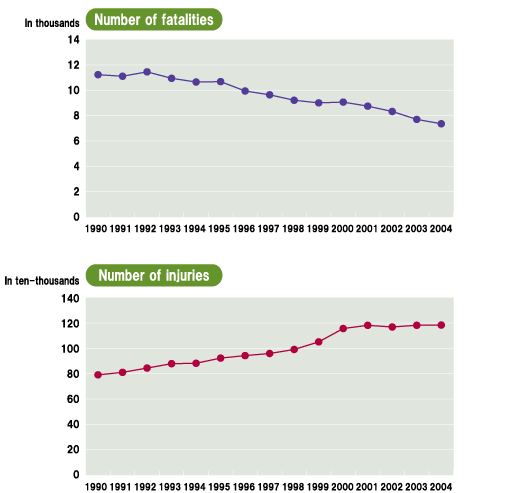Based on the characteristics of the following errors that occurred in crossing collisions, it is crucial to
practice defensive driving in order to prevent the "devaluation of the fundamentals of judgment".
[At intersections]
1) Be on the alert for vehicles visually even if believing there shouldn't be any other vehicles present.
2) Make sure that there is no one concealed behind fences or buildings.
Many accidents occur due to negligence, laziness, and lack of confirming safety because drivers think
the light is green or they have the right of way or that there is little traffic.
Also, accidents where the driver "just checked it" or "checked in advance that there was nothing else (intersecting vehicle)" or otherwise properly checked in advance,
but did not recheck the situation immediately before the accident are not uncommon.Approximately 21%
of the 1259 accidents where recognition errors occurred among vehicles in intersections were those where "building, fences, roadside trees, weeds, etc. visually obstructed the intersection".
It is because the intersections have poor visibility that the driver must pay more attention than usual.
[If Vehicle Is Seen At Intersection]
1) Although a driver may see the other driver, the other driver may not necessarily be looking back.
It is crucial that the driver keep his eyes on the other vehicle.
2) Be rational in judgment/prediction, not hopeful or anticipatory. Accidents often occur due to mistaken judgment/prediction that "one can proceed first" even after recognizing the other driver.
An overview of the factors that led to errors reveals a startling common point among Parties A and Parties B that "the other driver saw us".
[Be Cautious of Changing Traffic Lights]
There are many drivers that ignore traffic lights because they had just seen them and therefore did not
recheck them when entering the intersections.
There are also many drivers that deliberately ignore traffic lights because they judged that even though their own lights were red, the lights of the intersecting roads would not immediately change to green.
On the other hand, the number of cases where a Party B did not hesitate in accelerating once the traffic light turned from red to green and collided with another vehicle that ignores (or fails to check) its traffic light is
quite noticeable. In this study, there were 45 such cases. These correspond to about 10% of the 429 Parties B and about 35% of the 130 intersections where traffic lights were installed.
[Be Sure To Stop And Check For Other Vehicles At Stop Sign]
There are many vehicles that ignore stop signs because "there are no other vehicles, so it is OK to ignore the sign". Stop signs are often installed at intersections with poor visibility.
There are many cases where the driver has been unable to spot the other vehicles with just a quick check
while driving. Thisleads to accidents.
[Use Traffic Mirrors But Be Sure To Also Check With Your Own Eyes!]
About 86% of drivers that were in accidents at intersections with traffic mirrors did not use
the traffic mirrors (it is not known whether they noticed the traffic mirrors).
The results of this study show that 12% of drivers did not properly recognize the other driver for
reasons such as image distortions caused by the convex mirrors, dirt on the mirrors,
or inappropriate orientation of the traffic mirrors.
|





 Introduction
Introduction
 Contents
Contents